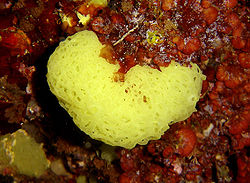| Clathrina | |
|---|---|
 | |
| Clathrina clathrus | |
| Scientific classification | |
| Domain: | Eukaryota |
| Kingdom: | Animalia |
| Phylum: | Porifera |
| Class: | Calcarea |
| Order: | Clathrinida |
| Family: | Clathrinidae |
| Genus: | Clathrina Gray, 1867 [1] |
| Synonyms | |
| |
Clathrina is a genus of calcareous sponge in the family Clathrinidae. Several species formerly in Clathrina were transferred to the newly erected genera Arturia , Ernstia , Borojevia , and Brattegardia in 2013. [2] The name is derived from the Latin word "clathratus" meaning "latticed".

